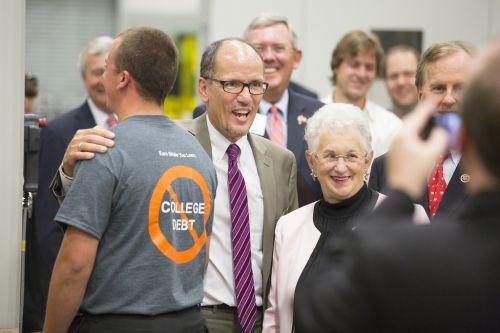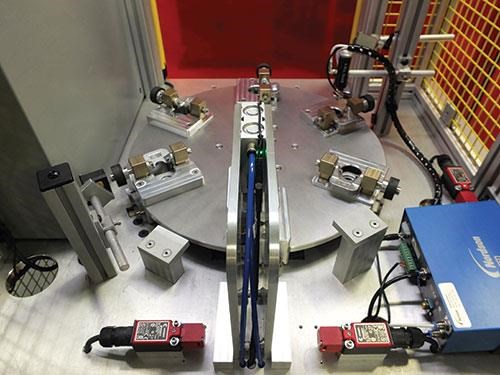People First
Whatever the topic, all our recent coverage of this mold manufacturer evidences a heavy reliance on and appreciation for its staff.

U.S. Labor Secretary Thomas Perez (center) visited Ameritech with U.S. Reps Robert Pittenger (R) and Virginia Foxx (R), both visible to the right, last month. As implied by the message on the back of this apprentice's shirt, many of the company's newer hires could have a virtually debt-free pathway to the middle class. (Image courtesy of US Department of Labor, Public Affairs.)
This month’s profile article isn’t the only recent coverage we have to offer on Ameritech Die and Mold. Back in April, company president Steve Rotman penned a short column about the Mooresville, North Carolina shop’s specialist approach to production. Around the same time, I wrote a brief blog post on the opening of a new business venture outside of manufacturing plastic injection molds. Shortly thereafter, the shop started getting attention from the highest levels of government, and that news led to another blog post.
Ameritech certainly has lot going on these days, but that’s not the only takeaway from all this coverage. All of the articles also touch on a common theme: a heavy reliance and appreciation for what I’ve heard Rotman and other shop owners call their “most valuable resource:” People.
Consider the most robust piece, the August-issue profile. This article focuses on the advantages of driving production through engineering, a strategy many shops have adopted as part of the much-touted shift from “mold making to mold manufacturing.” At Ameritech, this approach has helped streamline and standardize processes, in part by facilitating efforts to extend the use of robotics beyond just operations associated with EDM. However, it’s also significantly impacted how people are trained. As detailed in both the profile and Rotman’s aforementioned column, the shop’s apprentices now follow a tiered system that grooms them to become specialists in certain aspects of the build.
Those apprentices are literally the lifeblood of Ameritech, where the average age of the staff is only about 35, Rotman says. The youth of the Ameritech team is testament to a longstanding focus on workforce development, one that significantly predates the industry-wide handwringing over this crisis today. Back in 1995, the shop became a founding member of Apprenticeship 2000, a program inspired by Swiss models that has been wildly successful. Successful enough, in fact, to warrant a visit just last month from the U.S. Secretary of Labor and two Congressional representatives as part of a search for models that can be replicated throughout the country.

Developed at Ameritech Automation, this system is used to assemble dust caps into watertight plugs used by electricians running underground power lines.
Finally, the evolution of the shop’s new business venture, Ameritech Automation Systems, demonstrates that success in any business often comes down to relationships with others. The new venture, which opened its doors in Florida in late 2014, focuses not on mold manufacturing, but on automation systems for pick-and-place, degating, assembly and other operations commonly performed by custom molders. Although the focus here is essentially on taking people out of the equation, it took a somewhat fortuitous series of both personal and business connections to get off the ground.
What’s the takeaway from all this? The title of that last piece on Ameritech Automation, “All About the People,” says it all. Ameritech certainly had to rely on the latest technology and processes to get where it is today. Yet, whether supporting its own staff or leveraging outside relationships, it’s never lost sight of the fact that the people behind the technology remain as important as ever.
Read Next
Reasons to Use Fiber Lasers for Mold Cleaning
Fiber lasers offer a simplicity, speed, control and portability, minimizing mold cleaning risks.
Read MoreHow to Use Strategic Planning Tools, Data to Manage the Human Side of Business
Q&A with Marion Wells, MMT EAB member and founder of Human Asset Management.
Read MoreHow to Use Continuing Education to Remain Competitive in Moldmaking
Continued training helps moldmakers make tooling decisions and properly use the latest cutting tool to efficiently machine high-quality molds.
Read More.jpg;maxWidth=970;quality=90)







.jpg;maxWidth=300;quality=90)











